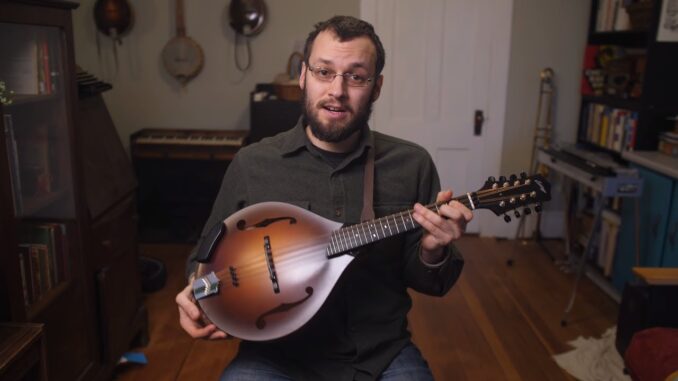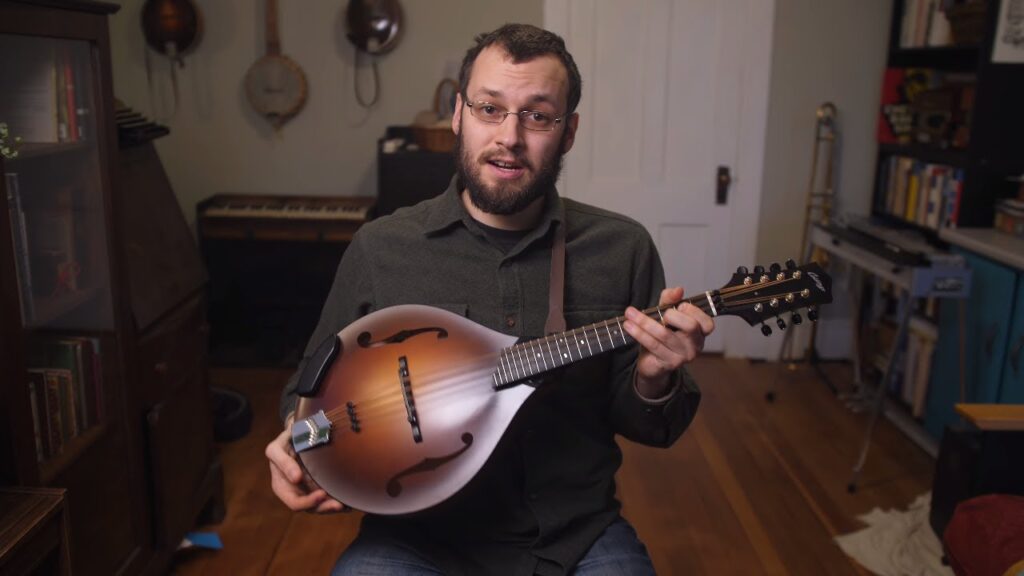
For centuries, string instruments with plucked melodies have captivated audiences worldwide. Among them, the mandolin family holds a special place, offering a vibrant tapestry of tones. While the mandolin reigns supreme, its lesser-known cousin, the mandola, deserves a closer look.

What is a Mandola?
The mandola (also known as the tenor mandola or mandola tenor) is a fretted string instrument belonging to the lute family. Sharing a strong resemblance to its mandolin counterpart, it differentiates itself through its:
- Size: Slightly larger than a mandolin, the mandola boasts a longer scale length (typically around 42 cm compared to the mandolin’s 33 cm).
- Tuning: Typically tuned in fifths (C-G-D-A), an octave lower than the standard mandolin tuning (G-D-A-E). This lower tuning allows for a richer, mellower sound compared to the mandolin’s bright and crisp tones.
- Strings: The mandola typically features four sets of doubled courses (eight strings in total), similar to the mandolin. However, some variations exist, including five-course or six-course mandolas.
How to Play the Mandola?
Learning to play the mandola shares many similarities with mastering the mandolin. Here’s a basic overview:
- Holding the Instrument: The basic posture involves cradling the mandola’s body against the player’s chest, similar to a guitar. The left hand presses the strings on the fretboard to create different pitches, while the right hand plucks the strings with a plectrum (pick) or fingers (pizzicato).
- Tuning: As mentioned earlier, the standard tuning is C-G-D-A (fifths apart), mimicking the viola. Tuning variations exist, requiring adjustments to finger placement.
- Chords and Techniques: Players utilize a variety of techniques like chord shapes, scales, arpeggios, and tremolo (rapidly alternating picking on a single course) to create melodies and harmonies. Learning mandolin techniques provides a solid foundation for the mandola.
Origins of the Mandola
The exact origins of the mandola remain shrouded in some mystery. However, historians trace its ancestry back to the medieval period, with instruments like the medieval mandora and the Renaissance colascione considered its predecessors.
Here are some key points about the mandola’s historical journey:
- Early Evolution: Instruments similar to the mandola appeared in Europe as early as the 11th century. These instruments varied in size and tuning, but the basic design principles laid the groundwork for the future mandola.
- The Rise of the Mandolin Family: By the 16th and 17th centuries, the mandolin family began to flourish in Italy. While the mandolin gained wider popularity, the mandola carved its niche in some regions and musical styles.
- Shifting Popularity: Throughout the 18th and 19th centuries, the popularity of the mandolin family fluctuated. While the mandolin gained mainstream recognition, the mandola remained a somewhat less common instrument.
- Modern Revival: The 20th century witnessed a renewed interest in folk music and historical instruments. This led to a resurgence of the mandola, particularly in its role within Irish and Celtic music traditions.
The Mandola’s Place in Music
The mandola offers a unique tonal palette, enriching various musical styles:
- Folk Music: The mandola finds a comfortable home in Irish and Celtic folk music, blending beautifully with fiddles, flutes, and bodhráns. Its lower register complements the melodies of other instruments.
- Italian Traditional Music: In some regions of Italy, the mandola remains a cherished instrument used in folk ensembles and traditional music performances.
- Early Music Ensembles: Modern ensembles specializing in Renaissance or Baroque music sometimes utilize the mandola as a historically accurate instrument.
- Contemporary Music: While less common, some contemporary musicians have incorporated the mandola’s rich sound into their music, adding a distinctive flavor to their compositions.
Mandola vs. Mandolin: Choosing Your Instrument
Both the mandola and the mandolin offer unique sonic possibilities. Here are some factors to consider when choosing between them:
- Desired Sound: If you prefer a deeper, mellower tone, the mandola could be the perfect fit. If you crave the mandolin’s bright and projecting sound, it might be the better choice.
- Playing Style: For those comfortable with larger instruments, the mandola’s longer scale length may be preferable. If you have smaller hands, the mandolin’s shorter scale length might be more comfortable.
- Musical Genre: If you’re drawn to Irish or Celtic music, the mandola’s presence in those styles might be a deciding factor. If your focus leans towards classical mandolin repertoire, the mandolin is the natural choice.
The Mandola: A Versatile Voice
Despite its niche status compared to the mandolin, the mandola offers a captivating voice. Its rich, mellow tones add depth and warmth to various musical contexts. Whether you’re drawn to the charm of traditional folk music or seeking to explore new sonic possibilities, the mandola is an instrument waiting to be discovered.
Taking the First Steps
If the mandola piques your interest, numerous resources are available to help you embark on your musical journey:
- Learning Materials: Instructional books and online tutorials can guide you through the basics of mandola playing. Consider seeking a qualified mandola or mandolin teacher for personalized instruction.
- Mandola Communities: Online forums and communities dedicated to the mandola can provide valuable support, learning resources, and a sense of connection with other players.
- Listening Inspiration: Immerse yourself in music featuring the mandola. Explore recordings of Irish folk ensembles, Italian traditional music groups, or contemporary artists incorporating the instrument.
The mandola is an instrument with a rich history and a promising future. By understanding its characteristics, origins, and place in music, you can appreciate its unique sound and explore its potential in your own musical endeavors. So, pick up a mandola, strum its strings, and discover the beautiful voice waiting to be heard.
Notable Mandola Players
- Donal Lunny (The Dubliners, The Chieftains): An Irish music legend, Donal Lunny is a master of multiple instruments, including the mandola. His work with iconic groups like The Dubliners and The Chieftains popularized the mandola’s sound within Irish folk music. Lunny’s intricate playing and ability to blend seamlessly with other instruments solidified the mandola’s place in the genre.
- Enya: The ethereal soundscapes of Enya’s music often feature the mandola’s rich tones. While not her primary instrument, she incorporates the mandola to add depth and texture to her atmospheric compositions. Listen to songs like “Orinoco Flow” or “Caravans of Hope” to hear the mandola’s subtle yet impactful presence.
- John Doyle (Solas): Hailing from Ireland, John Doyle is a virtuosic musician who has embraced the mandola alongside the bouzouki and guitar. His work with the acclaimed group Solas showcases his impressive skills on the instrument. Doyle’s intricate fingerpicking and use of ornamentation techniques breathe life into the mandola, creating captivating melodies and harmonies.
- John McEuen (The Nitty Gritty Dirt Band): An American music icon, John McEuen is known for his banjo and fiddle playing with the legendary Nitty Gritty Dirt Band. However, he has also explored the mandola’s potential, incorporating it into some of the band’s recordings. His playing style reflects the bluegrass and folk influences of the band, showcasing the mandola’s ability to blend seamlessly within Americana traditions.
- Ashley MacIsaac: The fiery fiddling of Ashley MacIsaac is a cornerstone of Cape Breton fiddle music. However, he has also experimented with the mandola, adding a touch of warmth and depth to his energetic performances. MacIsaac’s use of the mandola demonstrates its versatility, venturing beyond traditional folk settings and into the realm of contemporary Celtic music.
Check out our extensive resource of Free Mandolin Tabs
Mandolin Interviews
Trevor Moyle Interview
Alon Sariel Interview
Dan Beimborn Interview
Kevin Macleod Interview
Dagger Gordon Interview
Alison Stephens Interview
Gary Peterson Interview
Ian Harris Interview
